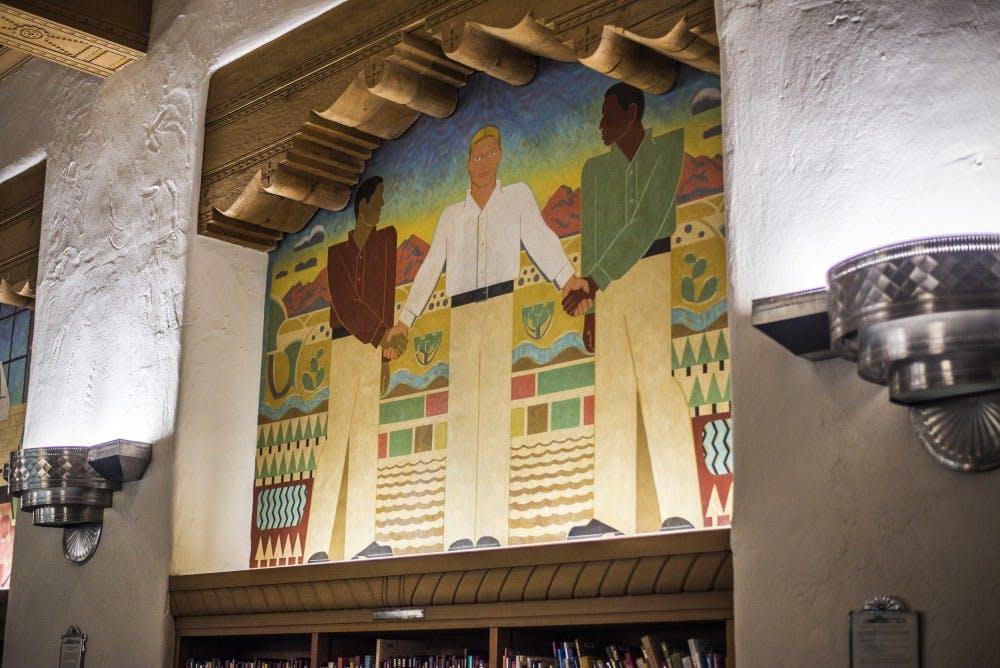A white man, blonde hair and blue eyed, stands center frame. On either side of him, a Native American and Spaniard face the Anglo and extend a hand. The Anglo holds his hands out to them and, while his blue eyes are wide open, the Native and Spaniard eyes are closed as they face the Anglo rather than stare straight ahead.
The image is one out of four frames that make up a controversial work of art in Zimmerman Library.
The “Three Peoples Murals” in the West Wing of the library, painted by Kenneth Adams in 1939, has been protested and defaced over time, yet preserved by UNM.
Whether the mural should remain has been debated by experts on racial politics as well as historical preservers.
UNM Peace Studies Director Jamal Martin said the mural is not in an appropriate setting to introduce dialogue or be used as an educational tool.
“If the aesthetics of art and culture serves as an educational tool, then this mural ought to help explain and help us analyze the transitions of control of the American Southwest and race relations,” he said.
Audra Bellmore, a curator at the Center for Southwest Research, wrote about the mural in an article for the 2013 New Mexico Historical Review, saying that the art was at the center of heated discourse in the ‘70s.
“Protesters twice splashed paint on panel four, requiring extensive and expensive restoration,” Bellmore wrote, adding that protesters held a rally debating the mural in the ‘90s.
She went on to write that the murals serve as a sort of time capsule to another era in which societal norms were very different than contemporary standards.
“The University fortunately preserved the murals, which today serve as a teaching device to demonstrate how to read artwork in historical context and how meanings, informed by cultural and societal transformations, change overtime,” the article states. “The dominant Anglo culture of the time probably considered these images to be liberal and progressive.”
Though Native American Studies Director Gregory Cajete understands the argument for education through historical preservation of public works, he said there’s “something to say” for changing artifacts of an older ideology to reflect attitudes and perspectives of the time.
In his book, “The Culture of Tourism, The Tourism of Culture: Selling the Past to the Present in the American Southwest,” UNM architectural historian Chris Wilson explains that James Zimmerman — UNM president for 19 years in the early 1900s — initiated the mural project with good intentions, but did not achieve the attempted reflection of progressive ideology.
Get content from The Daily Lobo delivered to your inbox
“Despite President Zimmerman’s laudable desire to ‘reflect the spirit of democracy by representing the culture of the three races as socially equal,’ the murals convey racial and gender hierarchies in a variety of ways,” Wilson wrote.
Wilson noted, aside from race, the gender inequality of the mural: “All but one of the women, for instance, kneel or sit, while all but one of the men stand. In terms of ethnicity, a majority of the figures in the Indian and Spanish panels are female, while the Anglo panel is male,” he wrote.
Wilson went on to point out the differences in cleanliness made apparent in the murals’ depictions of different races.
“In the final panel, the Anglo holds the central, authoritative position. Indeed, (he) is the only figure in the series with open eyes," he wrote. "That the baby set amid symbols of modern technology at the center of the previous panel is the only child in the murals implies that the future belongs to Anglo descendants.”
Wilson wrote that the ideological hierarchies of the mural “became painfully transparent following the civil rights movement,” and that students “repeatedly protested for their removal through the early 1900s.”
“Many argue (including me) that they should be preserved as historical artifacts and an object lesson of the subconscious prejudices that can be embedded even in populist program,” he wrote.
Cajete said UNM needs to hold a discussion about the mural, adding that there are other public art works around UNM that have similar connotations. Discussions led by the Kiva Club and Red Nation have already been ongoing on campus for months about the potentially “racist” nature of UNM’s official seal.
“Public works might first be viewed in a positive light, but later become sites of protest as politics change,” Cajete said. “Whether it should come down or remain needs to be a consensus between the current community,” he said, adding that the current consensus is more relevant than past interpretations.
Sara MacNeil is a news reporter at the Daily Lobo. She can be reached at news@dailylobo.com or on Twitter @sara_macneil.






